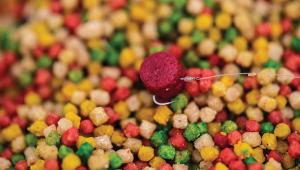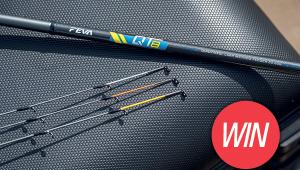Get More From The Method

There can’t be any more popular tactics when it comes to feeder fishing on commercials than the Method feeder. Mould some groundbait or pellets, or maybe both, on the base of the feeder with your hook bait trapped inside and cast it out. Simple isn’t it? However, there are many different types of bait presentation you can achieve with this feeder technique and today I want to talk to you about the type of presentation that I’m looking to achieve every time I cast my Method out.
The most common, accepted way that a Method feeder works when it comes to getting bites, is that anglers are trying to execute a type of presentation where there’s a neat pile of bait on the bottom with a hook bait sitting nicely in the centre of it. While there’s no doubt that type of presentation works, I think it’s more suited for those days when the fish are feeding aggressively early or late on in the session or match, or on those red-letter days when the tip is going round as soon as it hits the deck, indicating the fish are feeding aggressively.
The Presentation
My belief is that there is a higher percentage of fish that don’t feed in that way and quite often on more heavily fished venues where the fish have become educated, you have to wait for a wary fish to find your bait and then gain its confidence enough that it decides to eat it. So what I’m trying to achieve with my Method feeder approach is to have that all-important central core of bait, but I also want some bait to explode off the feeder so I have some loose offerings surrounding that core. Then, I’m looking for my hook bait to kick out away from the feeder so it’s among the first items of food a fish finds. 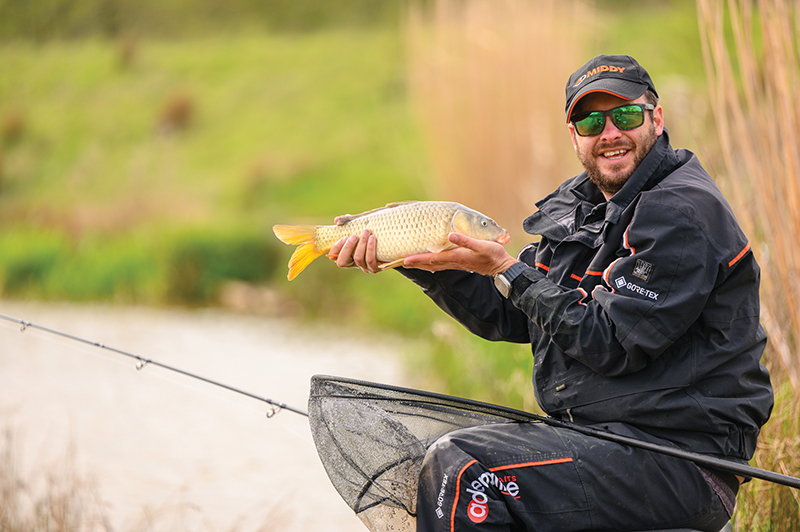 In my mind it’s very unlikely that a fish will ignore the first bit of bait it finds, which hopefully is my hook bait, and swim past it to get to the central core. Logically, the fish are more likely to have a sample of what’s on offer outside the core first and if your hook bait is there you’re raising the probability of it being picked up.
In my mind it’s very unlikely that a fish will ignore the first bit of bait it finds, which hopefully is my hook bait, and swim past it to get to the central core. Logically, the fish are more likely to have a sample of what’s on offer outside the core first and if your hook bait is there you’re raising the probability of it being picked up.
Making It Work
So, how do I achieve this type of presentation? I do prefer a Method feeder for this rather than a Hybrid because it allows me to mould the bait on to the feeder exactly how I need it to be. I’ve got two groundbaits mixed up and the first of these is a wet mix that is quite heavy and sticky and will break down slowly, this is for the core, and I’ve also got a very dry groundbait for the outer skin that will release from the feeder quickly and surround the feeder. The groundbait I use is the Betaine Green Adrenaline Mega Byte and it’s perfect for this because it’s really fine so when mixed dry it melts away instantly and when mixed wet it stays as a condensed ball. I also add a few micros to both mixes but it’s predominantly groundbait because I don’t think I can achieve what I want to with pellets alone or with a mix that’s predominantly micros.
To load the feeder I use a mould and the wet mix goes on first and when adding I really squeeze it hard on to the feeder. Basically if you get this right you’ll still have most of the core on the feeder when you retrieve or when you net a fish and you’ll have to clean the feeder before adding more bait for the next cast. The reason I want this core to stay on the feeder is because it gives my drier mix, that I cover the core with, the elevation it needs to fall off over a wider area.  After loading the wet mix on, I then place my hook bait into the mould and then cover it with my dry mix and press it on. I place the hook bait at the edge of the mould because I want my hook bait to be at the front of the feeder rather than central so it will flick off the feeder and land that bit further away from it. That elevation gives the hook bait more chance to properly fall off the feeder, which is the presentation I’m looking for.
After loading the wet mix on, I then place my hook bait into the mould and then cover it with my dry mix and press it on. I place the hook bait at the edge of the mould because I want my hook bait to be at the front of the feeder rather than central so it will flick off the feeder and land that bit further away from it. That elevation gives the hook bait more chance to properly fall off the feeder, which is the presentation I’m looking for.
The Setup
My rig is also slightly different to the norm that most anglers use. Today I’m on the Arena Lake at Cudmore and I’m using an inline Grippa Method feeder that’s running on a long length of 10lb fluorocarbon. The length I use is if I’m holding the feeder in my hand, the fluorocarbon would then have a couple of turns on the reel and keeping an eye on where the knot is also helps me know when a fish is in netting range.
My hooklength is very short and attached to the end of the fluorocarbon with an Albright knot, which is the same knot you’d use to tie on a shockleader. The thinking behind it is that I’ve got a section of very stiff line below the feeder that acts like a boom and will naturally kick out the hook bait once the groundbait around it has fallen away to release it and it will hopefully land on the perimeter of the bait. 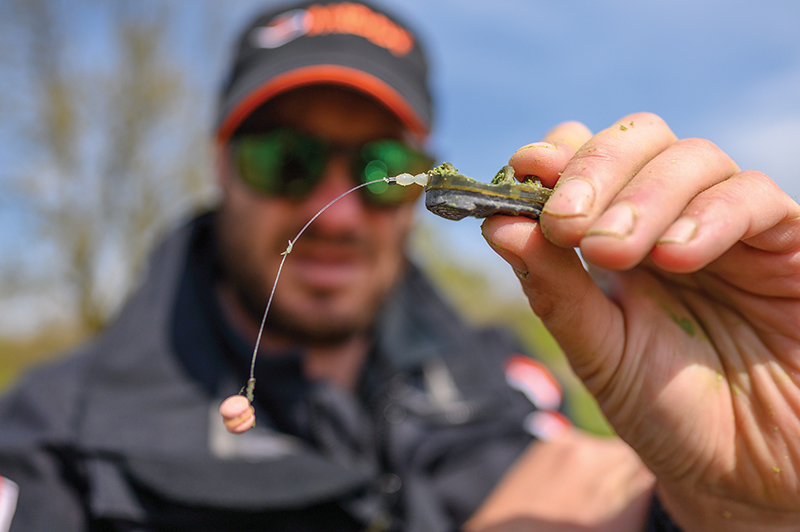 The feeder is inline and I’ve placed a couple of rubber float stops on the line to stop it rather than using a bead, which most anglers would use to attach the hooklength. The good thing about these is that they allow me to instantly change the length of my hooklength if I need to, which is a lot quicker than unclipping a hooklength and then attaching another one if, for example, you wanted to change it from three inches to four inches.
The feeder is inline and I’ve placed a couple of rubber float stops on the line to stop it rather than using a bead, which most anglers would use to attach the hooklength. The good thing about these is that they allow me to instantly change the length of my hooklength if I need to, which is a lot quicker than unclipping a hooklength and then attaching another one if, for example, you wanted to change it from three inches to four inches.
I always like to test in a bucket of water how my hook bait is behaving with the groundbait I’ve got mixed up before I start fishing and I can then lengthen or shorten my hooklength accordingly to make sure it’s kicking out away from the feeder just how I want it to. I think three to four inches is about the right length for me, I don’t particularly like hooklengths shorter than that for carp because I don’t think the hook has enough time to turn after a fish has sucked it in to get an effective hook-hold. 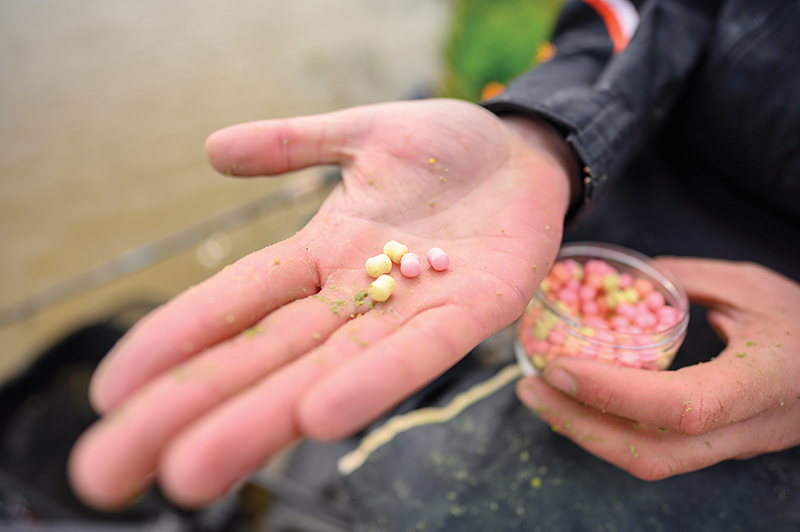 So everything about my setup is geared towards enabling my hook bait to flick off the feeder and land on the perimeter of my loose offerings that are released from my dry groundbait mix. It’s quite different from how most anglers would think about presentation with a Method feeder and I’m sure most of you would want your hook bait sitting right in the middle of your feed. Like I said earlier, that works really well when the fish are feeding aggressively but on most occasions I find this style of presentation works really well for me.
So everything about my setup is geared towards enabling my hook bait to flick off the feeder and land on the perimeter of my loose offerings that are released from my dry groundbait mix. It’s quite different from how most anglers would think about presentation with a Method feeder and I’m sure most of you would want your hook bait sitting right in the middle of your feed. Like I said earlier, that works really well when the fish are feeding aggressively but on most occasions I find this style of presentation works really well for me.
The Session
Today we’re on the Arena Lake at Cudmore and I’ve got two Middy 5G rods set up, a nine footer and a 10 footer, and I started the session on the shorter rod casting around three-quarters of the way across to try and get a feel for what mood the fish were in. After 15 minutes with no indications, I changed to the longer rod casting tight across, which is a distance of around 30 metres on this lake. However, it wasn’t easy because with a strong wind blowing straight into my face, even casting that relatively short distance was a challenge at times and I found myself waiting for lulls in the wind before casting out! It’s calm water tight to the island and the fish definitely seem to be sitting out of the wind so that’s been the only area where I can catch today. 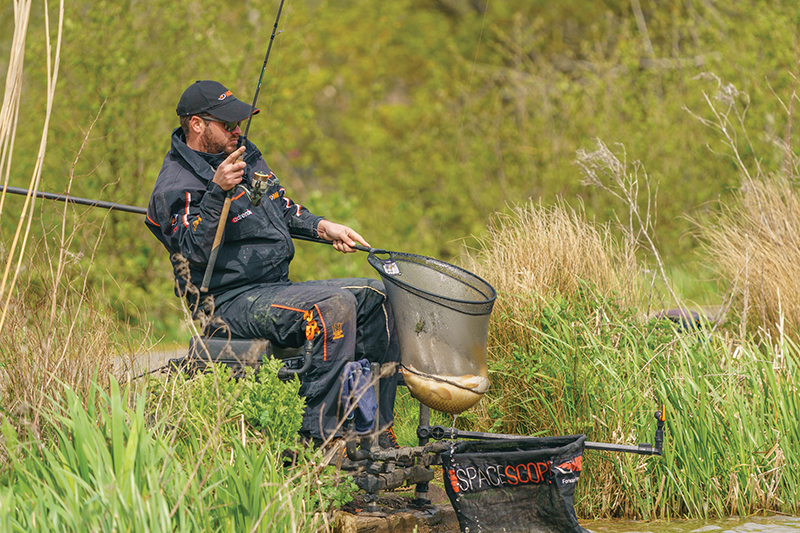 When I do land the feeder in the perfect spot it’s taken around four minutes on average to get a bite so on casts where I don’t get any indications I’m only leaving the feeder in for six minutes before reeling in. We’re in the first week of May shooting this feature and it’s still not properly warmed up, so in terms of the fishing we’re still in early spring mode really. The bites are coming in spells and I’m having to cast to different areas to try and keep fish coming regularly, but casting to the clam, warmer water that’s not affected by the chilly easterly wind is the best tactic.
When I do land the feeder in the perfect spot it’s taken around four minutes on average to get a bite so on casts where I don’t get any indications I’m only leaving the feeder in for six minutes before reeling in. We’re in the first week of May shooting this feature and it’s still not properly warmed up, so in terms of the fishing we’re still in early spring mode really. The bites are coming in spells and I’m having to cast to different areas to try and keep fish coming regularly, but casting to the clam, warmer water that’s not affected by the chilly easterly wind is the best tactic.
It’s the perfect day to show you my approach really because on days like today when the fish aren’t hanging themselves, your presentation needs to spot on and I know mine is because when I do get a bite it’s coming between three and four minutes after casting. I’ve ended the session with around 70lb of carp and a skimmer, and I hope that after reading this it encourages you to just think a bit more about your presentation and what you want achieve from it when you’re fishing the Method. Too many anglers simply put bait (in most instances these days it’s micro pellets) on the feeder with the hook bait right in the middle of it without thinking too much about it. There is a time and place for that but when the carp aren’t feeding aggressively try and think a bit more about trying different presentations and maybe give the presentation that I’ve showed you today a try.
Use a couple of different groundbait mixes and see if it makes a difference for you and try the hooklength style that I’ve showed you that flicks the hook bait – my favourite is a washed-out Band’Um Sinker – away from the feeder and see how you get on. It’s only when you start trying these alternatives that you can really get an edge in matches. 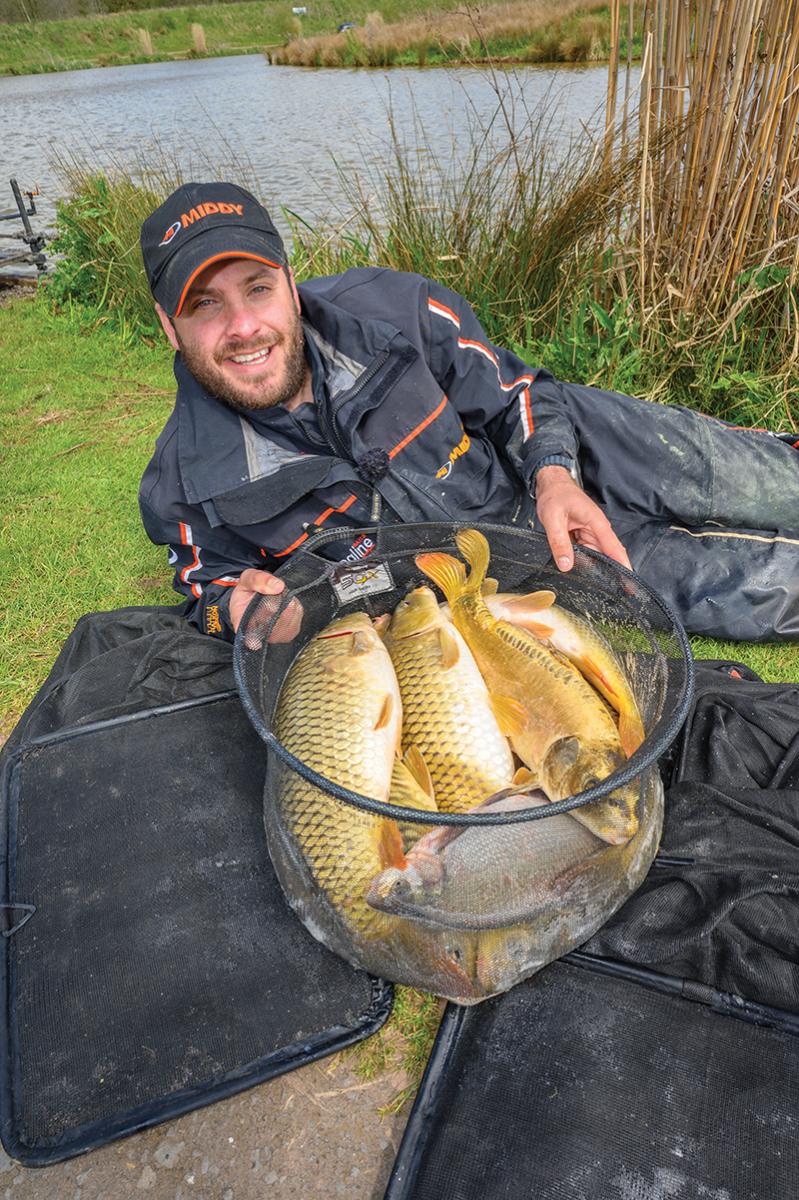
- Log in or register to post comments





